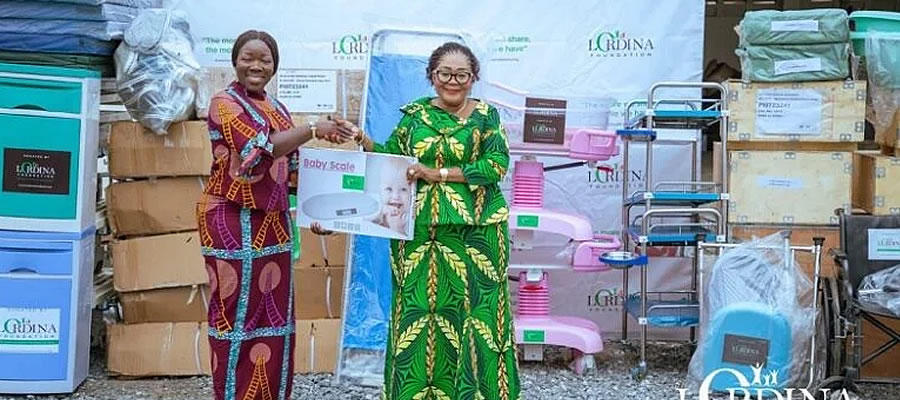

The District has over twenty permanent resident ethnic groups, namely Akans/Bono, Gonjas, Dagombas, Sisalas and Mamprusis. Each group has its own local head and displays its own culture. However, the Bonos are the natives of the land, with their own unique traditions and culture. The Chiefs in the District derives their authority from the Techiman Traditional Council which is constituted by twenty eight Divisional Chiefs including the Omanhene. The council is currently headed by the Omanhene and President of the Techiman Traditional Council, Oseadeyo Akumfi Ameyaw IV.
The existence of ‘Bono’ Takyiman is clearly distinct from the various branches forming the Akan culture. It has developed as heir of the Bono Manso, the capital of the first Bono Empire. The main aspects of the Bono identity may be described as follows; particularised linguistic origin, historical personality, performance and celebration of distinct and original festivals, religious practices and beliefs and modern political identification. The Bono dialect is based on clear linguistic differences; it constitutes one of the major dialects of the Akan language.
Historically, Takyiman has its roots in what has been described as the Kintampo culture or pre-historic civilisation. The beliefs and practices of the Techiman people are expressed in their worship of the deities and the “blackened” stools. Techiman has been the initiator and core of the movement for the resurgence and cultural revival of the Bono people which was known as Bono Kyempim Federation that gave birth to the Brong Ahafo Regional House of Chiefs.
The major festivals are the Apour and Yam festivals. The annual Apour festival is celebrated between April and May. The major significance is that it gives the citizenry the right to come out openly and criticise those in authority, with impunity. This demonstrates democratisation of the rule of law and good governance. It also serves as introspection for those in authority to re-assess themselves and make amends for any wrong doings, in order to promote effective development.
The yam festival is also celebrated annually between August and September to mark the two farming seasons. It serves as thanksgiving to the Almighty God and the ancestral spirits for a bumper harvest. This helps maintain the relationship between the ancestral spirits and the living.
The Techiman Traditional Council besides it traditional roles ensures peaceful co-existence among the various ethnic groups. It also promotes tourism and as the custodian of culture of the people.
Chieftaincy disputes have sometimes generated ethnic conflict and violence thereby endangering the peace and security in the District. The need to maintain peace and security in these conflict “hot-spots” have been a constant drain on the Assembly’s limited resources to the detriment of development of the communities. The protracted chieftaincy disputes in areas like Tuobodom, Offuman, and Buoyem need to be addressed to promote peace and facilitate community mobilisation for development.
Tourism
The tourism potential in the District has not been harnessed. The potential areas of tourist attraction include the chains of rocks, caves and wildlife within the environs. These areas have made the tourist destination in recent times. These scientific, cultural and aesthetic sites need to be developed as tourism products in collaboration with the traditional authorities and other stakeholders to create wealth and generate local employment.
Some of the potential sites include
• The world famous Buoyem Bat Sanctuary at Bouyem, which houses Rosetta fruit bats.
• The source of the sacred river Tano at Tanoboase and the sacred fish and crocodiles in the river.
• The Tanoboase sacred grove believed to be the cradle of Bono civilization.
• The grotto and Kristo Boase Monastery, the only known monastery in Ghana established by the Catholic
Church for the Benedictine monks which also serves as a place for religious activities and recreation.
• The undeveloped Ampenkro waterfalls at Asubingya.
• The rich culture and traditions of the Bono people including the chieftaincy institution, Apour and Yam festivals of
the chiefs and people.
The District has a few hospitality industries. However, the nearness of these sites to the Techiman Municipality encourages tourism into the District thereby boasting the number of nice hotels and guest houses as shown in table 1.14: below;
It is significant to note that Dery Hotel is located very close to Techiman Municipality. The standard and services of the hospitality industry need to be improved by encouraging the private sector to invest more to create employment. The strategic location of the district calls for the construction of standard hotel facilities with adequate rooms and facilities to attract visitors into the District.
Date Created : 11/21/2017 2:44:25 AM












 facebook
facebook
 twitter
twitter
 Youtube
Youtube
 +233 593 831 280
+233 593 831 280 0800 430 430
0800 430 430 GPS: GE-231-4383
GPS: GE-231-4383 info@ghanadistricts.com
info@ghanadistricts.com Box GP1044, Accra, Ghana
Box GP1044, Accra, Ghana